Climate adaptation

Cities actions on climate adaptation
The effects of climate change are making themselves felt across Europe’s cities. Indeed, as set out in the main survey analysis, close to 30% of mayors highlighted issues such as access to water, the effects of extreme heat, the challenge of promoting climate adaptation measures as well as advancing on decarbonisation and climate neutrality goals as their number one challenge overall in 2023, reinforcing this long- term trend.

The effects of climate change are making themselves felt across Europe’s cities. Indeed, as set out in the main survey analysis, close to 30% of mayors highlighted issues such as access to water, the effects of extreme heat, the challenge of promoting climate adaptation measures as well as advancing on decarbonisation and climate neutrality goals as their number one challenge overall in 2023, reinforcing this long- term trend.

The Eurocities Pulse Mayors Survey further found that the number one climate change induced hazard that mayors feel threatens their cities, according to 65% of the mayors who reported specific hazards, is extreme heat.
Heatwaves and other extreme weather events have beset Europe’s cities with more frequency and ferocity. 2023 was the hottest year ever recorded. London has engaged its local councils and made use of its strong ties with the voluntary sector to protect rough sleepers from dangerous summer heatwaves by repurposing its Severe Weather Emergency Protocol, initially developed for freezing winters, to switch from providing heat blankets to sunscreen. Meanwhile, Athens has created the innovative position of Chief Heat Officer. One of the most effective solutions to reducing urban temperatures is to have more plants and water features. Trees and bushes, rivers and canals all have a cooling effect that cities like Budapest are exploiting to the full.
Flooding, the second-most highlighted climate hazard (mentioned by 55% of those who shared their hazards), is emblematic of the diversity and universality of the perils that climate change has in store for Europe’s cities. Given their geographic distinction, the types of flooding that cities face are diverse, including burst riverbanks, flash-flooding from rainfall, and coastal floods. Spectacular flooding events, such as those faced by German, Belgian and Dutch cities in 2021, and Italian cities in May 2023, have been punctuated by numerous smaller-scale but nonetheless devastating floods across the continent, a trend set to increase in the coming years.
Mayors’ awareness in terms of climate hazards

Top five sectors perceived as the most likely to be impacted by climate change
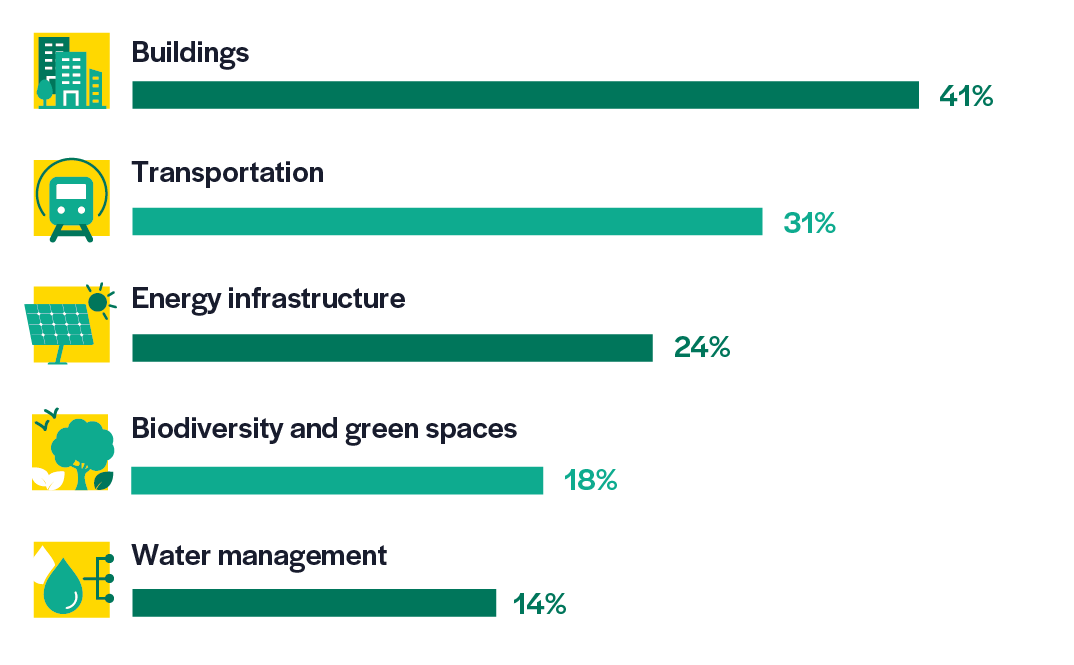
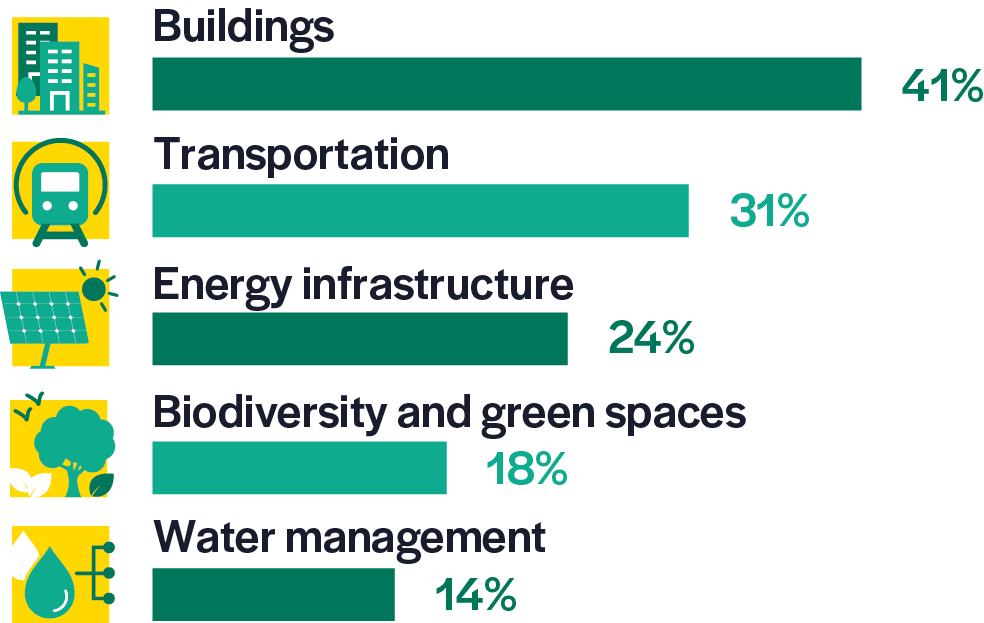
Cities across Europe have been steeling themselves against this threat with an array of measures, often employing nature-based solutions that have knock-on benefits for local communities. Copenhagen’s Cloudburst initiative involves creating new public spaces, such as skateparks or playing fields, designed to sequester excess water during heavy rainfall. Braga’s community ownership approach facilitates schools and other organisations wishing to ‘adopt’ sections of its river, which they clean and maintain while using for educational and other purposes. To protect residents from flooding, the ‘Turin, City of Water’ initiative is reinforcing four riverbanks while creating green areas for recreation, as well as mobility options for walkers and cyclists.
Flooding, extreme heat, and other climate hazards put many municipal sectors at risk. Mayors are almost universally aware (84%) of the at-risk sectors in their territories, that they perceive to have the greatest vulnerabilities and are bracing themselves for severe impacts from these hazards across all municipal sectors. Namely, buildings (41%), transportation (31%) and energy infrastructure (24%), were considered most at risk, while mayors also expressed concern related to biodiversity and green spaces (17.5%), water management (14%) and health (14%).
Financing urban adaptation
2023 marked the hottest year on record, with expectations for global temperatures to rise even more, intensifying climate change effects. The European Climate Risk Assessment highlights Europe as the fastest warming continent, outpacing the efforts of current policies and adaptation measures.

by Ambroise Fayolle
Vice President of the European Investment Bank
Cities, bearing the brunt of extreme weather events and biodiversity loss, house nearly 340 million people in the EU and produce 85% of its GDP. To safeguard citizens, businesses, and critical infrastructure, while maintaining economic competitiveness, it’s crucial to increase investment in making urban areas more climate resilient.
The good news is that adaptation is increasingly a priority for cities. According to a recent survey by the European Investment Bank of 744 municipalities, over 60% plan to increase their investment in climate change mitigation and adaptation over the next three years. Despite these efforts, as the Eurocities Pulse Mayors Survey confirms, access to funding and financing for adaptation actions is considered the top challenge for mayors seeking to move forward on climate adaptation. Modernisation and infrastructure adaptation remain the primary focus across all EU regions. For example, Portugal’s National Climate Act envisages over 300 local climate action plans. This is supported by national and local-level resilience-oriented construction standards and requirements.
This March, the European Commission published a communication on managing climate risks – protecting people and prosperity. The Commission underlines that attracting and facilitating private investment is fundamental to successfully addressing climate risks and building climate resilience. The European Investment Bank is working closely with the Commission, as well as countries, cities and the private sector to finance adaptation measures. Last year, we devoted a record €2.7 billion to adaptation projects globally. We aim to do even more this year and in the years to come.
The Bank has several financial instruments and advisory services to support adaptation measures in cities. We are financing large infrastructure projects in areas such as climate change resilient urban transport and flood prevention across the EU. In addition, urban framework loans to municipalities are especially well-suited to support investments in adaptation.
Framework loans help cities to finance medium-to long-term capital investment programmes. They are useful because adaptation investments are typically needed across many sectors, such as water and transport infrastructure, and may comprise numerous small projects that would be difficult to finance individually. The European Investment Bank’s framework loans also finance other objectives including clean energy, hospitals and schools. Moreover, the loans can be drawn down over several years, to match a city’s project preparation capacity and the availability of other financing.
Recent examples include the EIB’s framework loan to the City of Florence to support its Urban Development and Climate Strategies – including investments in river restoration, bio-diverse water retention basins, sustainable drainage solutions, and sustainable mobility. We also financed Krakow’s City Adaptation Plan, which includes sustainable mobility, green spaces and public buildings such as schools and hospitals.
The EIB’s ADAPT advisory platform, offers cities a range of advisory services to support their adaptation plans. For example, we have worked with the Lisbon Metropolitan Area on the project pipeline of its Climate Change Adaptation Strategy, helping to identify priority projects and additional adaptation measures. In the Italian city of Taranto, we are advising on the implementation of investments under the city’s Green Belt strategy, which includes urban parks and green areas to restore degraded land. In addition, we are working with the region of Andalucia to integrate climate change considerations into its sustainable urban mobility planning.
Social considerations need to figure prominently in climate adaptation projects. This is because lower income and vulnerable citizens tend to be at greater risk, as they are both more likely to live in vulnerable locations and less able to relocate. They are also less able to invest in the resilience of their homes, or otherwise adapt to extreme weather events. There is a need to build a just resilience to the impacts of climate change, at the same time as there is a need for a just transition away from fossil fuels towards low-carbon technologies.
To cope with the inevitable consequences of climate change, cities need to invest much more in adaptation measures and their capacity to prepare and deliver them, which is a challenge for many with constrained budgets. To assist, the EIB is looking at innovative financing structures to unlock investments in adaptation, such as using revenue streams from mandatory or voluntary payments from businesses or citizens wishing to avoid future climate change-related damages.
The EIB seeks to deepen its relationships with cities and urban areas across the EU. City networks like Eurocities have an important convening power that allow us to discuss investment barriers and adaptation priorities with cities and show potential solutions. We are here to help. Call us.

by Ambroise Fayolle
Vice President of the European Investment Bank
Central challenges
The recently released European Climate Risk Assessment notes that Europe is the fastest-warming continent, likely to face significant increases in temperatures, sea level, and heatwaves and droughts. Emphasising the need for urgent action, the report identifies 36 major climate risks, with 21 requiring immediate attention, and signals risks to health, economies, ecosystems, and infrastructure. Though no cities are spared, Southern Europe, low-lying coastal areas, and the outermost EU regions face the greatest risk.
We need a strong Green Deal for the next EU.
– Anna Lisa Boni, Deputy Mayor of Bologna
Top challenges in implementing climate change adaptation measures
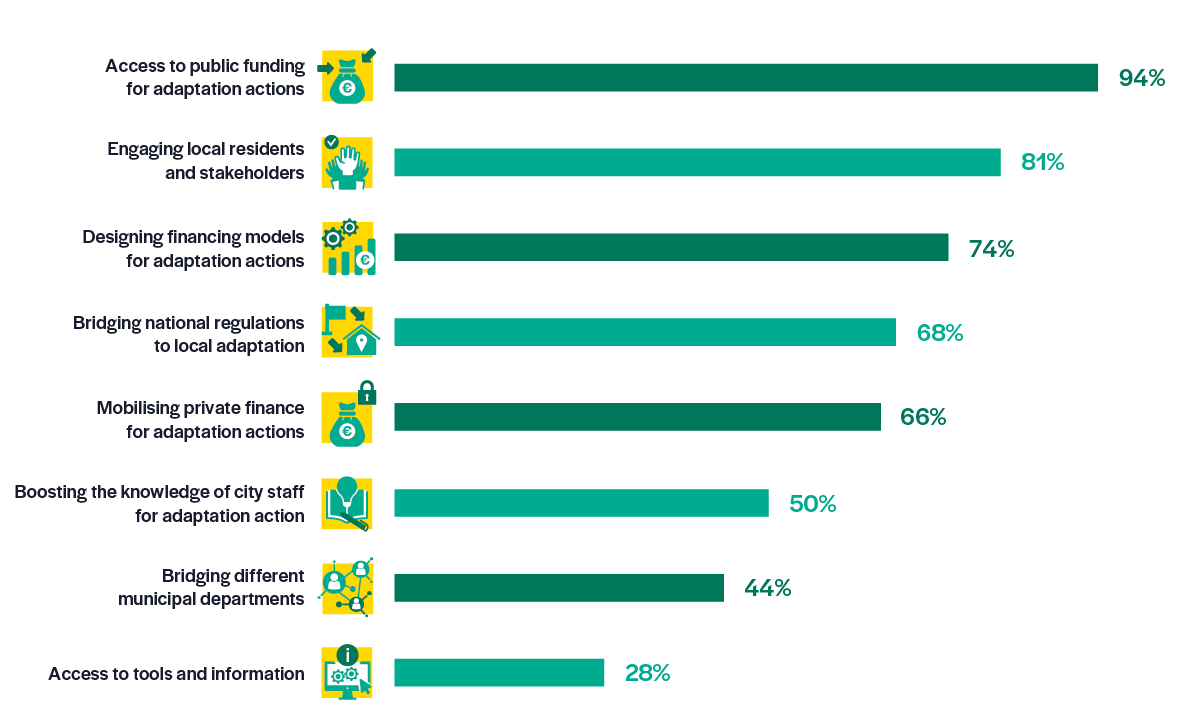
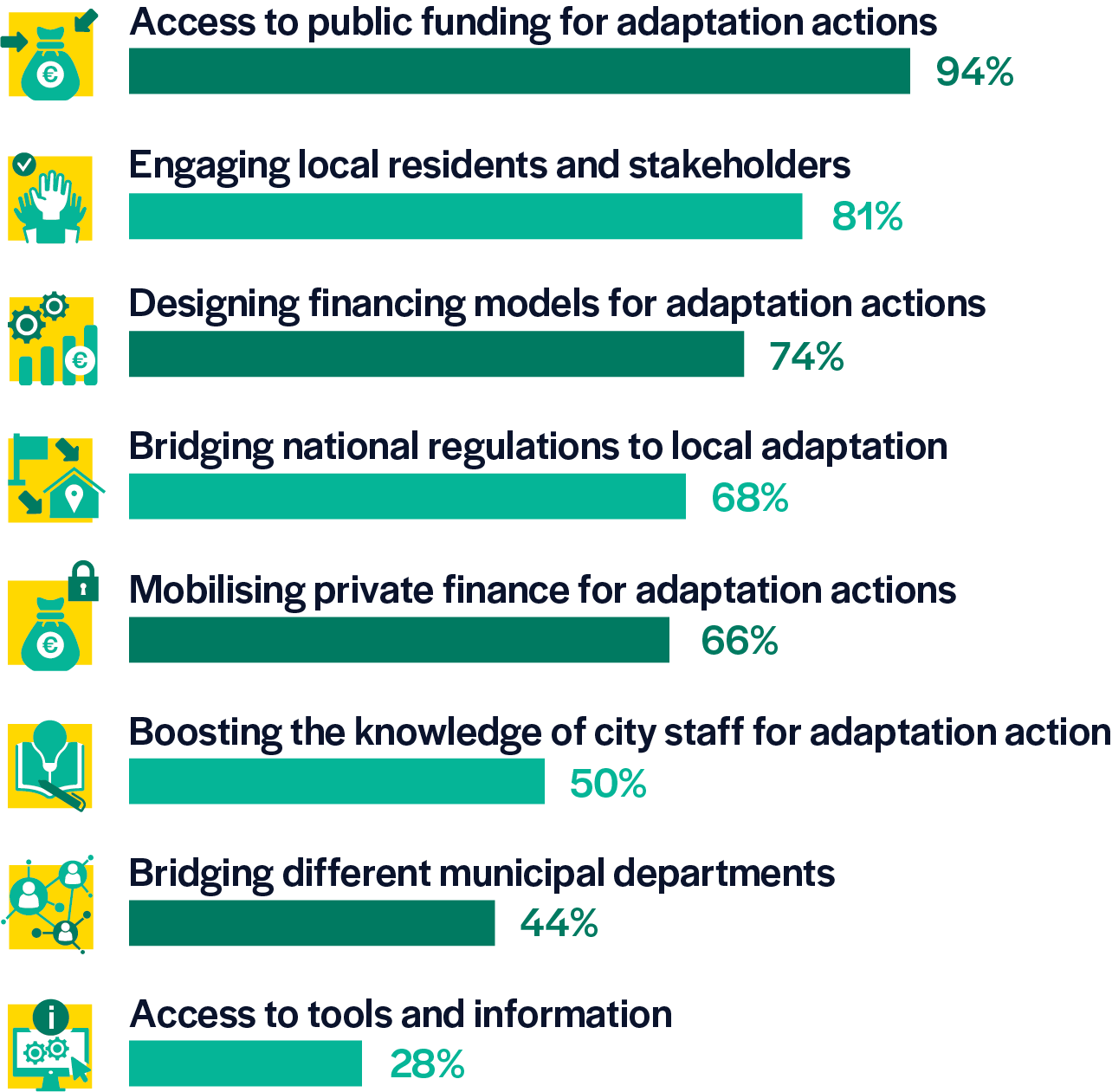
The key challenge that mayors report to be hindering their adaptation actions is funding and financing, with 94% choosing this at their top challenge related to climate adaptation overall.
Available funding, however, is not sufficient for the scale of the challenge cities have to face, and recovery from climate impacts is very costly for cities. Given this, cities are working to design financing models for adaptation actions (the third greatest adaptation challenge at 74%), and to mobilise private finance for adaptation actions (the fifth most pressing adaptation challenge at 66%), as further explained in the guest essay from Ambroise Fayolle.
Globally, funding for climate adaptation measures lags far behind that for reducing emissions. According to the Climate Policy Initiative, 2021-22 saw €58.59 billion allocated for adaptation globally, just 5.5% of the €1,069.5 billion allocated to mitigation, while €47.43 billion was dedicated to activities that benefitted both. The EU is working to address this imbalance, but there remains a lot of catching up to do.
The Paris Climate Bond, raised €300 million to fund climate adaptation and mitigation projects, including planting 20,000 trees and creating 30 hectares of new parks, offering 1.75% annual profit to investors prioritising sustainability. Hamburg incentivises green roofs with €3 million in funding from the Ministry for Environment and Energy and the Senate Office. The city then offers non-refundable subsidies for up to 60% of installation costs, and is aiming for 100 hectares of green roofs by 2029. Bratislava has secured over €2.4 million from European Economic Area and Norway grants, complemented by city funds, for greening and water retention projects, including a €50,000 grant scheme for small-scale sustainable drainage projects for private, NGO, and business applicants.
Climate mitigation projects have a more obvious pay-back for private investors, as they can reap the dividends from energy saving directly, while the economic benefit of adaptation is less tangible. Nonetheless, given that the EU incurred approximately €650 billion in damages between 1980 and 2022 from extreme weather events, there is a clear economic case for equipping local government with the necessary resources to mitigate and adapt. The potential economic damages from coastal floods alone in the EU could exceed €1 trillion every year by the century’s end under a high emissions scenario.
Engaging local residents and stakeholders was the second most widely shared challenge overall (81%). As the examples from Braga, Copenhagen and Turin above demonstrate, adaptation action often involves transformation that has an immediate and tangible positive effect within cities. As it may represent major changes within urban space, engaging local residents and stakeholders is a must. However, it’s also a way to harness local energy and great ideas, and to demonstrate all the benefits associated with climate action.
Sometimes, as with Debrecen’s urban community gardens, local authorities tap into existing local impulses and facilitate their growth and reproduction. In other cases, such as Espoo’s work on biodiversity with construction companies, the city can share its ambitions with local actors and invite them to invent ways of contributing. And often, as in the case of Cagliari’s rejuvenation of its canal, the municipal government includes everyone in city-wide consultation and ensures that major infrastructural development creates opportunities for all sectors of society.
Other key adaptation challenges that mayors highlighted were bridging national regulations to local adaptation (68%), boosting the knowledge of city staff (50%), bridging different municipal departments (44%), and access to tools and information (28%). Climate adaptation is a shared competence between the EU and member states. However, despite the fact that there are national adaptation strategies in place, in all but nine member states local adaptation is largely driven by cities and regions and not by the national level. This underscores the importance of local action, which often happens in spite of a lack of sufficient support for local policy coming from the national level.

Adaptation priorities
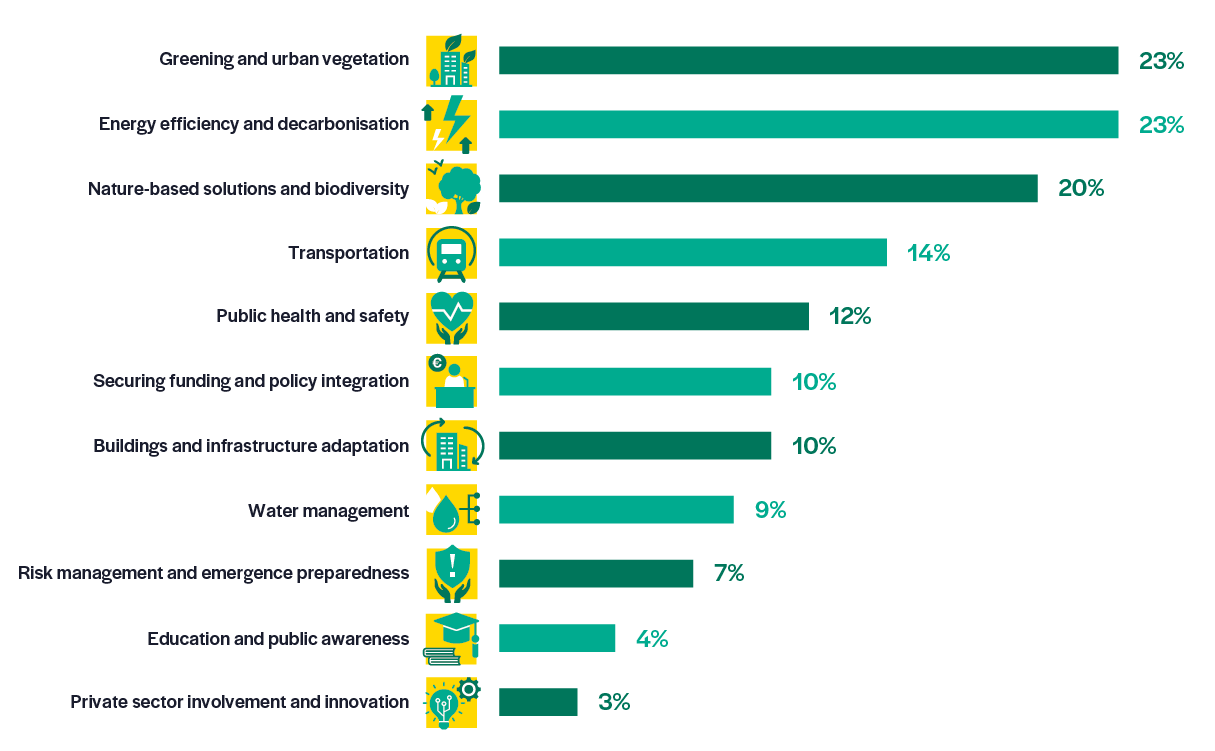
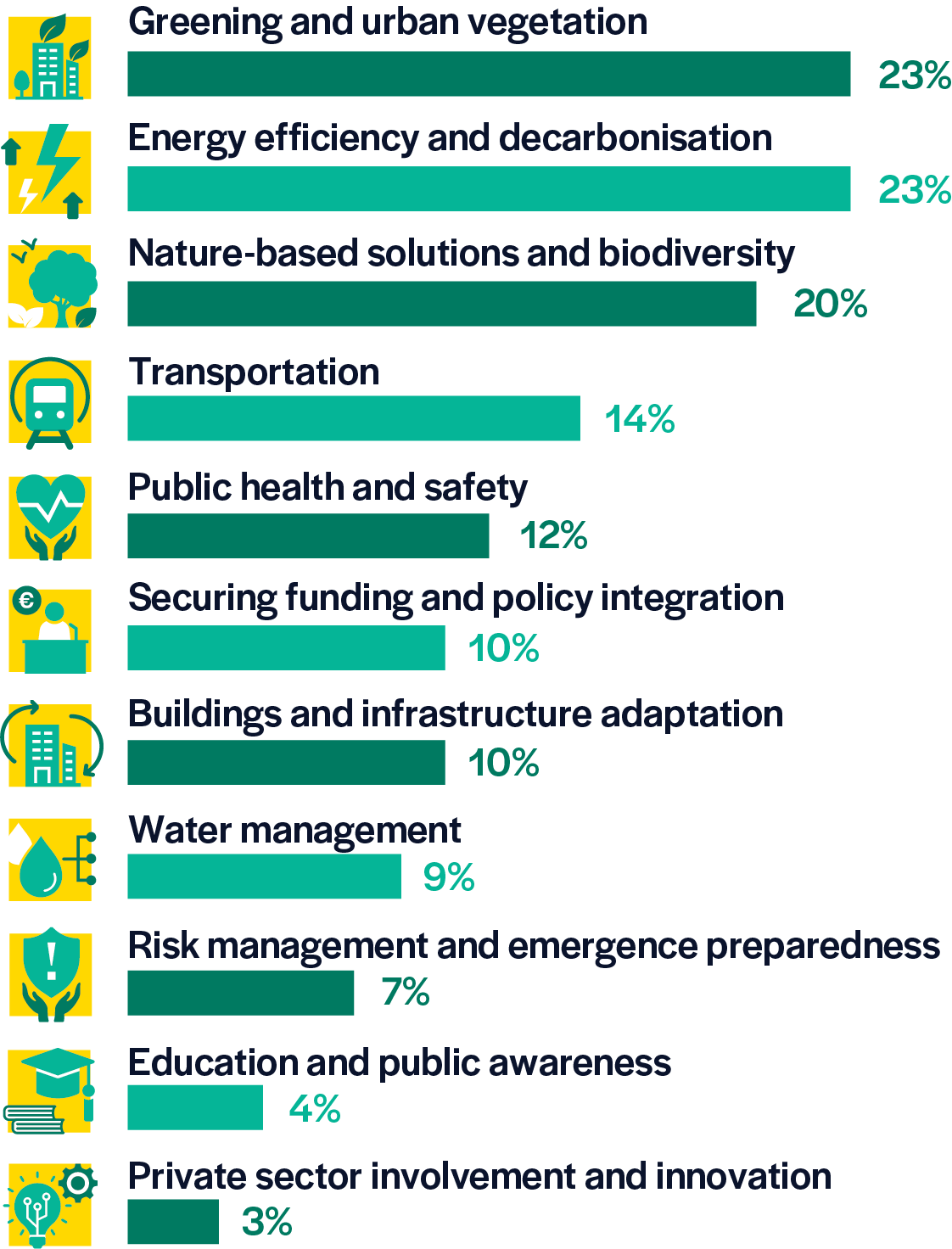
Asked about their priorities for climate adaptation, mayors listed greening and urban vegetation in joint first with energy efficiency and decarbonisation (23% each). This tied first choice demonstrates how conducive adaptation efforts are to unleashing co-benefits, that is to say, positive knock-on effects for other areas of local policy.
Green spaces, such as parks, green roofs, and trees act as natural cooling systems, reducing the urban heat island effect, improving air quality by filtering pollutants, and act to enhance biodiversity by providing habitats for various species. These green spaces are also vital for the mental and physical health of urban populations, offering environments for recreation and relaxation.
Such nature-based solutions, which was the third priority of mayors for climate adaptation, cited by 20% overall, are also often more economically attractive than traditional infrastructural solutions. Hamburg’s green roof programme, mentioned above, is far less expensive than a rehaul and expansion of sewer infrastructure for stormwater management would be.
There is also much crossover between adaptation, mitigation and energy efficiency-focused solutions. For example, energy-efficient refurbishment of buildings with better insulation and more effective heating and cooling technology can make residents more comfortable during heatwaves; trees and plants capture carbon from the air while acting against overheating and flooding; and less carbon-intensive transport options like cycling or electric buses also reduce congestion and pollution, which can exacerbate the urban heat-island effect.
Other priorities for mayors include transportation (14%), public health and safety (12%), adapting buildings and infrastructure (10%) and water management (9%).

EU response
The European Commission responded to the recent European Climate Risk Assessment with a Communication on Managing Climate Risks. This communication highlights a discrepancy between the ambitions and the actual implementation of climate adaptation policies among EU member states, emphasising the need for improved governance and resources at all levels. The Communication also points out the need for better coordination and resource allocation to address climate risks effectively. However, despite cities being key implementers of climate adaptation initiatives, Eurocities has pointed out that the Commission’s response does not adequately recognise the role of local governments.
Nearly 90% of Eurocities members have adopted plans to protect their residents from the effects of climate change. As seen above, these strategies often include nature-based solutions to enhance resilience and address urban heat, drought, and flooding. The European Commission stresses the importance of nature-based solutions but acknowledges challenges in financing these initiatives over traditional infrastructural solutions.
The creative approaches of Europe’s cities to tackling climate adaptation while bringing about co-benefits for local communities will be vital to ensuring the resilience of Europe as the hazards of climate change become more widely felt. Empowering local leaders to have a seat at the table of national and European policy making in this area is the only way to ensure that Europe is ready to adapt.

